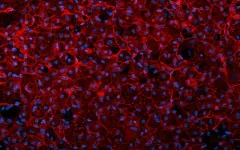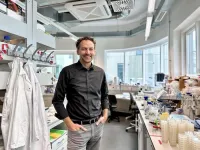An hereditary liver disease cured with the help of gene scissors
Researchers at the University of Helsinki and HUS Helsinki University Hospital have succeeded in correcting a gene defect that causes a hereditary liver disease and its adverse effects on cells.
2024-04-04
(Press-News.org)
Argininosuccinate lyase deficiency (ASLD), also known as argininosuccinic aciduria, is a disease that has been enriched in the Finnish genetic heritage. In this severe metabolic disease, the body does not process proteins normally, instead resulting in a very dangerous accumulation of argininosuccinic acid and ammonia. Excess ammonia causes disturbances of consciousness, coma and even death.
In Finland, infants are screened for ASLD to determine the disease risk before symptoms develop. The treatment is an extremely strict lifelong diet and, in severe cases, a liver transplant.
Researchers from the University of Helsinki and HUS Helsinki University Hospital have succeeded in correcting the gene defect associated with argininosuccinic aciduria and demonstrated that the harmful metabolism caused by the disease can be cured.
In their recently completed study, they initially modified the skin cells of patients with ASLD into stem cells. Subsequently, the researchers reprogrammed the disease-causing gene defects in the stem cells using the CRISPR-Cas9 technique, known as gene scissors. Finally, the researchers guided the corrected stem cells to differentiate into liver cells to see whether the disease that impairs hepatic function was actually cured and that the fixed cells no longer produced the harmful argininosuccinic acid.
“In our study, we demonstrated for the first time that the gene defect causing ASLD can be corrected with gene scissors without any adverse effects visible in the cells. The gene-corrected cells were also metabolically improved,” says Docent of Stem Cell Biology Kirmo Wartiovaara, specialist in medical genetics, from the University of Helsinki and HUS.
The study was published in the esteemed American Journal of Human Genetics.
Researchers discover a suitable “gene mixture” in a drug already in use
In the study, the researchers used mRNA encapsulated inside lipid nanoparticles to get the gene scissors inside the cultured cells.
“This ‘gene mixture’ we produced is based on the formula of a pharmaceutical product already in use, which may facilitate its clinical use in the future. Our next goal is to cure ASLD in mice,” says Doctoral Researcher Timo Keskinen from the University of Helsinki.
“The same gene editing technique works on living animals and humans, but we don’t yet know how safe it is. This is why the matter has to be investigated first in laboratory animals,” Keskinen adds.
Therapeutic potential at last for hereditary diseases
There are already more than 7,000 hereditary diseases in the world. Finns, as well as other populations originating in small groups of people, have their own genetic disease variants that are more common in the population than elsewhere in the world. Many of these gene variants of our distant ancestors are such that if a child inherits the same variant from both parents, they may develop a severe disease.
Treatments are available for only a handful of hereditary diseases, and curative therapies are even more rare.
“However, a cure could be possible if the gene defect causing the disease is eliminated entirely. Thanks to basic research carried out with the help of gene scissors and other precise gene-editing techniques, permanent fixes are gradually starting to emerge,” Wartiovaara says.
The study is part of the doctoral theses of Sami Jalil and Timo Keskinen, supervised at the Biomedicum Stem Cell Center of the Biomedicum Helsinki research institute by Docent Kirmo Wartiovaara and Mervi Hyvönen, DMedSc.
END
ELSE PRESS RELEASES FROM THIS DATE:
2024-04-04
New York (April 4, 2024) — Today, the American Geriatrics Society (AGS) and the AGS Health in Aging Foundation (HiAF) announced that the 2024 Thomas and Catherine Yoshikawa Award for Outstanding Scientific Achievement in Clinical Investigation will be awarded to C. Barrett Bowling, MD, MSPH, Associate Professor in the Division of Geriatrics at Duke University School of Medicine.
The award will be presented at the AGS 2024 Virtual Annual Scientific Meeting (#AGS24), May 9-11 (pre-conference days May 7 & 8). At the conference, Dr. Bowling will deliver a lecture on “Geriatricizing” Chronic Disease Research: A Geriatrician’s ...
2024-04-04
During archaeological excavations in the Schöningen open-cast coal mine in 1994, the discovery of the oldest, remarkably well-preserved hunting weapons known to humanity caused an international sensation. Spears and a double-pointed throwing stick were found lying between animal bones about ten meters below the surface in deposits at a former lakeshore. In the years that followed, extensive excavations have gradually yielded numerous wooden objects from a layer dating from the end of a warm interglacial period 300,000 years ago. The findings suggested a hunting ground on the lakeshore. An interdisciplinary ...
2024-04-04
Bacterial proteins often play a successful hide and seek game with the body’s immune system, making it difficult to combat the bacteria that cause diseases like staph infections.
Now, biomolecular engineer Aditya Kunjapur and colleagues have come up with a strategy to create bacteria that build and incorporate a key amino acid into their own proteins, which makes the proteins more “visible” to the immune system.
For this work toward building a better platform for possible future bacterial vaccines, Kunjapur is the winner of the 2024 BioInnovation Institute & Science Prize for Innovation. ...
2024-04-04
A flexible electronic fiber that utilizes the human body as part of the circuit enables textile-based electronics without the need for batteries or chips, researchers report. According to the authors, the approach is well-suited for scalable manufacture of comfortable fiber-based electronics for a wide range of applications, including “smart” clothing. Textile electronic systems are designed to equip textile or fiber assemblies with electronic functions for sensing, computation, display, or communication. They create vast opportunities ranging from physiological monitoring to powering ...
2024-04-04
In this Policy Forum, Michael Cohen and colleagues highlight the unique risks presented by a particular class of artificial intelligence (AI) systems: reinforcement learning (RL) agents that plan more effectively than humans over long horizons. “Giving [such] an advanced AI system the objective to maximize its reward and, at some point, withholding reward from it, strongly incentivizes the AI system to take humans out of the loop,” write Cohen and colleagues. This incentive also arises for long-term planning agents (LTPAs) more generally, say the authors, and in ways empirical testing is unlikely to cover. It is thus critical to address extinction risk from these ...
2024-04-04
In asthma, the tightening of muscles around the bronchi causes damage to the airway by squeezing and destroying epithelial cells, which promotes the airway inflammation and mucus production often associated with an asthma attack, researchers report. The findings suggest that preventing the mechanical damage caused by an asthma attack, rather than treating only its downstream symptoms, could pave the way for therapies that stop the whole asthma inflammatory cycle. Asthma is a common airway disorder affecting more than 300 million people worldwide. Although it is primarily considered an inflammatory disease, a diagnostic feature of asthma is mechanical bronchoconstriction – the ...
2024-04-04
Promoting livestock biodiversity and soil conservation strategies provides both social and environmental benefits, according to a new study. The findings suggest that well-designed polices aimed at incentivizing the adoption of multiple diversification strategies could mitigate simplified agriculture’s negative environmental, health, and social impacts. “Our interdisciplinary analysis spanning a wide array of regions provides convincing evidence that agricultural diversification is a promising win-win strategy for providing social and environmental benefits,” write the authors. Agricultural lands tend to be simplified ecosystems designed ...
2024-04-04
After two decades in the United States, Martin Hetzer returned home to Austria in 2023 to become the 2nd President of the Institute of Science and Technology Austria (ISTA). A year into his new role, the molecular biologist remains engaged in the realm of aging research.
Hetzer is fascinated by the biological puzzles surrounding the aging processes in organs like the brain, heart, and pancreas. Most cells comprising these organs are not renewed throughout a human’s entire life span. Nerve cells (neurons) in the human brain, for instance, can be as old as the organism, even ...
2024-04-04
Scientists at King’s College London have discovered a new cause for asthma that sparks hope for treatment that could prevent the life-threatening disease.
Most current asthma treatments stem from the idea that it is an inflammatory disease. Yet, the life-threatening feature of asthma is the attack or the constriction of airways, making breathing difficult. The new study, published today in Science, shows for the first time that many features of an asthma attack—inflammation, mucus secretion, and damage to the airway barrier that ...
2024-04-04
It is possible to leave most of the lymph nodes in the armpit, even if one or two of them have metastases larger than two millimetres? This is shown in a trial enrolling women from five countries, led by researchers at Karolinska Institutet and published in the New England Journal of Medicine. The results open up for gentler surgery for patients with breast cancer.
Breast cancer can spread to the lymph nodes in the armpit. However, tumours found only in the breast and armpit lymph nodes are considered a localized disease, with the goal of curing the patient.
A challenging question for breast cancer surgeons revolves around what should ...
LAST 30 PRESS RELEASES:
[Press-News.org] An hereditary liver disease cured with the help of gene scissors
Researchers at the University of Helsinki and HUS Helsinki University Hospital have succeeded in correcting a gene defect that causes a hereditary liver disease and its adverse effects on cells.




